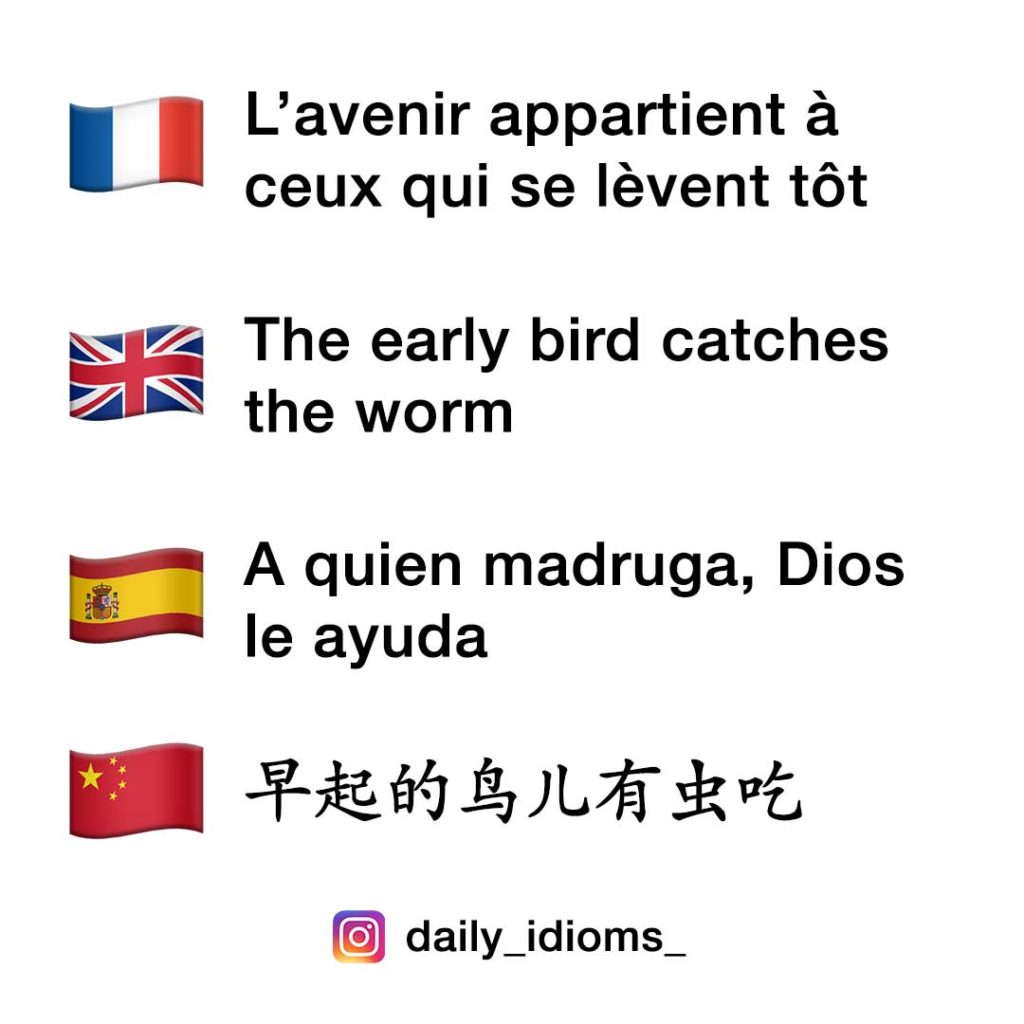Daily idioms in 4 languages
Dear readers,
I am happy to inform you that I have just created an instagram account in which I will now post, on a daily basis, a new idiom in 4 languages: French, English, Spanish and Chinese.
As a linguist, I am often looking for the right equivalence for an idiom. As a result, I had in mind to put it all together so as to help my work and benefit others’ work as well.
The account is “daily_idioms_” and you can subscribe here:

Here is an example:

Feel free to suggest me new idioms !
I hope you will find this account useful and look forward to hearing from you ! 🙂
Nouveaux mots 20/21
Bon, ça faisait longtemps que je n’avais pas écrit en français, ni écrit de liste de nouveaux mots. Eh oui, la langue évolue au fil du temps et avec les évènements de l’année dernière, de nombreux mots se retrouvent désormais dans notre dictionnaire.
Donc voici un florilège des termes nouveaux ou récurrents – et classés par ordre alphabétique, s’il vous plait! – des années 2020 et 2021. Je préviens à préciser que j’ai placé des intrus ici et là afin que vous les découvriez… eh ouais, c’est quand même plus sympa.
- Anantapodoton : Non, ce n’est pas un nouveau dinosaure – de toute façon, c’est bien connu, c’est Denver le dernier dinosaure. La définition se trouve plus bas et je vous laisse chercher un peu. 😉
- Antivax : se dit des personnes ou des mouvements contre la vaccination. Non, ce n’est pas le nom d’un robot, ni l’ennemi juré de Goldorak…
- Autonomisation : un mot que l’on trouve de plus en plus partout pour traduire le terme anglais empowerment. Le terme capacitation est quelques fois utilisé aussi. Processus par lequel une personne ou une collectivité se libère d’un état de sujétion, acquiert la capacité d’user de la plénitude de ses droits, s’affranchit d’une dépendance d’ordre social, moral ou intellectuel.
- Black bloc : groupe de militants extrémistes de gauche, anarchistes ou autonomes, organisés pour attaquer, souvent avec violence, les symboles de l’État et/ou du capitalisme (forces de l’ordre, banques, etc.) lors de manifestations. Leur nom vient de leur mode de déplacement, en bloc compact, et de leur tenue vestimentaire, noire.
- Brainstorming : on peut également dire “remue-méninges”.
- Covid (de CoronaVIrus Disease) : je pense pas avoir besoin d’expliquer, mais je tiens à souligner que de nombreux dictionnaires l’acceptent au masculin et au féminin. Personnellement, je dis le Covid car j’ai toujours considéré que c’était un virus et non une maladie (je pourrai même donc enlever le D de ce point de vue là) et je trouve que ça sonne mieux mais chacun fera son choix.
- Cluster : voici un mot anglais intéressant… En tant que traducteur, je ne comprends pas pourquoi l’expression “foyer de contamination” n’a que très peu été utilisée par les médias depuis le début de la pandémie… bref, apparemment, on peut l’utiliser en français maintenant.
- Confinement / Déconfinement : bref, l’explication est en confinement…
- Chatbot : programme informatique basé sur l’intelligence artificielle, capable de répondre en temps réel aux questions d’un internaute, faisant ainsi office de conseiller virtuel.
- Charlie : où est Charlie ? Avez-vous cherché partout?
- Distanciation sociale : acté ! Selon moi, la distanciation physique suffit car je crois que la distanciation sociale existait déjà bien avant la pandémie, n’est-ce pas ? Par exemple entre ceux vivant dans le 16e arrondissement de Paris et ceux du 93. ^^ Mais bon, c’est un terme à la mode…
- EMDR : non, ce n’est pas une modification de MDR (ou encore Emotional MDR… xD) mais une psychothérapie utilisant des mouvements oculaires et/ou des stimuli sensoriels en alternance à gauche, puis à droite, pendant l’évocation des souvenirs perturbants.
- Féminicide : meurtre d’une femme ou d’une jeune fille, en raison de son appartenance au sexe féminin.
- Gestes barrières : en anglais je vois souvent “barrier gestures” dans des traductions (du français à l’anglais) mais les anglophones trouvent souvent, et à juste titre, cette traduction bizarre – elle leur parle pas quoi ! – et cette expression est pour moi mal localisée. L’emploi de “protective measures” sonne bien mieux pour l’oreille d’un natif.
- Frugalisme : mode de vie consistant à vivre en dessous de ses moyens et à épargner afin de quitter la vie active bien avant l’âge légal de la retraite (à 35 ans environ), avec pour objectif de se soustraire à la société de consommation… Ou sinon, c’est peut-être aussi que t’es pauvre et que t’as pas le choix… 🙁 Mais c’est quand même plus classe de dire “Non, je pratique le frugalisme”, non? 🙂 🙂 🙂
- Gréviculture : SNCF, si tu nous écoutes… Tendance péjorative à recourir de manière quasi systématique à la grève, lors d’un conflit social, et à instituer ainsi un rapport de force avec le patronat, ou, plus généralement, la direction d’une entreprise, comme préambule à tout dialogue et à toute négociation. On parle aussi de « culture de la grève » ou « culture française » – la dernière expression est une boutade, bien entendu, quoique…
- Hygge : sentiment de bien-être et de sérénité caractéristique de l’art de vivre danois, fondé sur les plaisirs authentiques du quotidien ; par extension, cet art de vivre.
- Illectronisme : difficulté, voire l’incapacité, que rencontre une personne à utiliser les appareils numériques et les outils informatiques.
- Hipstérisation : transformation d’un lieu (quartier, ville, etc.) populaire par l’arrivée en nombre de hipsters. (On parle aussi de « gentrification », « boboïsation ».). Ce type de quartier peut également se reconnaître par un nombre élevé de trottinettes…
- Pansexuel : orientation sexuelle caractérisant les individus qui peuvent être attirés, sentimentalement ou sexuellement, par un individu de n’importe quel sexe ou genre.
- Polyamour : orientation et une éthique des relations amoureuses où les partenaires sont en relation amoureuse avec plus d’une personne, avec le consentement de toutes les personnes concernées.
- Présentéisme : quand on fait l’appel au télétravail (ou a l’école), que tu réponds “Présent !” et qu’après tu vas dans la cuisine te faire un bon café et que bon… (ceci est une véritable figure de style qui se nomme anantapodoton: variété d’anacoluthe où la rupture de construction se fait par suppression d’un élément normalement attendu dans une formule syntaxique généralement binaire)
- Quotient Emotionel / QE : capacité, évaluée par des tests, à percevoir ses propres émotions ainsi que celles des autres, à les comprendre et à les utiliser à bon escient (notamment pour atteindre un objectif clairement défini).
- Savoir-être : dépend aussi du QE et se démarque diamétralement du savoir-faire.
- Sexto : message électronique contenant des textes ou des photographies sexuellement explicites.
- Traçage numérique : souriez, vous êtes filmés… (et écoutés, bien sûr, sinon c’est pas marrant 😉
- Télétravail / télétravailler : si tu sais pas encore ce que c’est, tu devais pas être au sommet de ta carrière.
- Zèbre : animal ou, dorénavant une personne surdouée. Appellation de la psychologue Jeanne Siaud-Facchin afin de dépasser les représentations attachées aux termes « surdoué », « haut potentiel », « enfant précoce ».
Et voilà !

Eh non, c’est pas Charlie… Il n’a pas pu venir, il est en quarantaine.
Mais bon, Jamy est cool et il explique bien. Et puis il a presque les mêmes lunettes que Charlie. 🙂

Bon, j’arrête là pour cette fois… 😉 Bonne journée à vous ! 😉
Translators’ constraints
This week’s post will be on a reflection about 3 translators’ constraints: Space, NDAs and CAT tools.
There is much debate about how difficult it is to be a translator. Indeed, beyond the mere translation process itself, a translator might be subject to a lot of constraints. And for the neophyte who is just starting translating and hasn’t yet got much experience in translation, some constraints may prove bewildering.
For you guys to realise a bit more what it is like to be confronted with such constraints, I will do my best to present what I consider to be the most commonplace ones.
The conquest of Space

At first glance, it might sound odd to hear about space for someone who is not familiar with a translator’s work. But space is of the utmost importance for a translator. When I bring up space, I obviously mean framework, context and format.
Let me get this straight, if you have all the space you want for your translation, that’s great! But unfortunately, that’s not the case for:
- manga and cartoon translations
- subtitles and video translations
- video games translations
- technical translations… etc
This list is not exhaustive. What I hope to stress here is that the format in which the translation is performed matters a great deal.
You might have noticed approximate translations when watching a video and realise that the subtitles were not truly accurate. To err is human after all. But to be fair, this is just bound to happen because a great deal of such translations might also be due to the reduction of words or letters made in a previous translation.
One has to keep in mind that translations must sometimes be contained either in speech bubbles (for comics) or strings (for video games or subtitles). The translator’s work often consists in building a bridge between what should be an accurate translation and what can be held within the defined content.
Rewording must then take place to the detriment of an accurate and authentic translation, and translators are usually good at juggling with those elements to find a more stable balance. Translations purists might disagree but this is what happens, and we have no choice. In many cases, the format matters as much as the content.
It also happens that some other professionals change our translations afterwards, which might be quite upsetting for some translators. However, as previously mentionned, that might be due to the length of the translation, e.g. if the text was too big for a cartoon speech bubble.
It is important to remind you that a translator is just a part of a bigger chain in the editing/gaming/video process. Editors are usually the ones adapting the content to transform it into the end product. Even though translators or localisers often provide turnkey translation services, developers (for video games) or editors (for books) will have the last word. And their work is to check the content and see if it fits, which is equally important!
So next time you see a translation or subtitle that doesn’t quite fit the original text or message, you may want to ask yourself this: “Could such a long content be held into such a small format?”. In case of a video, one may wonder about subtitles and ask: “Is it fast enough for me to read it completely?”.
Because those parameters do matter.
NDAs and self-promotion

After having negotiated with your customer and agreed on the rates, you might have to sign a NDA (Non disclosure agreement) before starting to work.
This may come across as part of a natural process or as a standard procedure. There is nothing wrong with NDAs per se. Needless to say, no self-respecting LSP (Language Service Provider) would leak any information about their work before it is done and delivered. In addition, signing NDAs enables your clients to be reassured and that is a good thing.
However, as inticing and reassuring as it may seem for them, many clients do not require translators to sign NDAs and this is also a tricky part. Reassuring clients is one thing, but limiting your right for self-promotion is another.
Indeed, as a freelance translator, you need to show your work in order to exude confidence and prove your would-be customers that your work is all about quality. Displaying a portfolio is one of the best way to genuinely generate leads and showcase your linguistic abilities.
For instance, as a martial art practioner, I won’t just consider a black belt as a sign of know-how, I will also watch how the person behaves. In the 21st century, people have access to the internet and similarly, if they want to know more about you, the first thing they will do is enquire about you through search engines. Hence, a portfolio is paramount and you must be cautious over whether or not you are allowed by the NDA to display or quote your works after it is delivered to your client.
As a result, one should be able to ponder over self-promotion and NDA. While it may be beneficial for your customers that you sign a NDA, how much would you value the fact that you might not be able to talk about your works afterwards? There is no right or wrong here. It’s for you to decide.
What I obviously suggest is to read the NDA thoroughly. If some parts state that you are not allowed to use parts of the content for self-promotion, try to negotiate it with your clients. I believe most will not be opposed to it if it occurs after the work is done. So, don’t be too headstrong on self-promotion either. Reaching a middle ground to mitigate constraints is always a win-win, especially if the customer is happy with your work. That’s also self-promotion.
CAT tools: a constraint ?

Another typical example of how tools can affect your workflow is CAT Tools, which means Computer Assisted (or Aided) Translation tools. I believe most translators have heard of them and many use them too.
CAT tools are not constraints per se, and can be of great help because they reduce your translating time once you know how to use them. Some translators love them, whereas some don’t. Thus, there are pros and cons, and I won’t go into further details about them here, but the fact remains.
Some of your customers will need you to use one, such a Trados, SmartCat or any other. As a result, it can become a constraint in the sense that you will have to follow a training, or be able to use them so that you don’t lose any customer, because that would be a pity indeed.
The point being, the reasons for such use vary. Many firms will try to provide you with the best tools so that the translations reach an unprecedented level of accuracy and consistency. Others just use it because they need to check how many words you translate and how many repetitions take place so they can pay you less. Translation rates vary from 0% to 100% and you’ll probably hear of LQA (Localisation Quality Assurance) if you translate, say, video games for instance. That’s rather commonplace. They also might have technical glossaries, and they may come in handy.
Now, despite the loss of profit that those may bring about, their main constraint lies in your command of such tools. I personally believe most CAT tools are similar, but you need some time to get used to a new one, so that you’re not completely at a loss when you use the CAT tool chosen by your client.
If you haven’t used any CAT tools yet, I would advise you to train with 2 or 3 different tools, to try your hand and see for yourself what their benefits and shortcomings are. Doing so may enable you to become familiar with the different settings as well. The most prevalent one being Trados, I urge you to become familiar with it, since it is the most used in the translation industry. Indeed, this one is a no-brainer.
However, speaking of constraints, I need to add that Trados cannot be used on MacOs and the software is not free, which is a big no no for a translator who’s just starting up his own business… Every penny counts.
As a result, for those of you who use macbooks on a daily basis and hope to find free a CAT tool, an alternative must be considered. In case you want to train on Trados (using the trial period), you might install Windows on your MacOs with bootcamp if you have enough disk space (it requires at least 40Go). Alternatively, you might turn to other Mac-friendly CAT tools like OmegaT or others. Personnally I like OmegaT’s simplicity.
If you are more into TMs and need to use complex glossaries, SmartCat is not too shabby either. It’s the one I use when I need to add glossaries or TMs.
To recap, as a translator, I would advise any translator to be familiar with a few CAT tools. You may choose to use them or not, but being aware of what is used in the industry is always important. That’s part of business intelligence after all. However, bear in mind there are solely tools. It’s good to be able to use them but don’t depend too much on them (glossaries or TM) for your translations either, otherwise their use may prove to be at the cost of your abilities.
I, for one, rely on my skills and like putting my translating skills to the test on a daily basis… There’s so much to learn, and the way we see things change quite a lot over time. Since the brains is like a muscle, I am always on the lookout for improvement and fixed translations might be a trap! So beware and keep upgrading your skills!
May those skills enable you to cast off the shackles of the constraints I have just exposed today!

Well, that’s all for today. I haven’t covered all the constraints translators face on a regular basis but I might add a lot of data on the subject over time. I hope this post enabled you to understand the translator’s work a wee bit more. I might post more detailed info on CAT tools in later posts as well.
Till then, take care and stay safe! May the word be with you! 😉